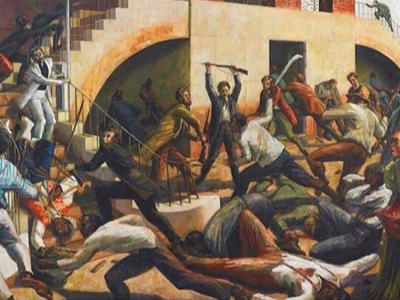The Morant Bay Rebellion was an uprising that took place in Jamaica on 11 October 1865. This rebellion is one of the most significant events in the history of the Caribbean nation, as it led to major political and social changes on the island. The revolt was a response to widespread poverty, social injustice, and the harsh living conditions faced by the majority of the population.
Background of the rebellion
Emancipation and the aftermath
Jamaica was a British colony where slavery was a deeply entrenched institution. However, with the passage of the Slavery Abolition Act in 1833, slavery was abolished, and the island’s enslaved people were granted freedom. This freedom, however, came with certain conditions, as those over the age of six were placed in an apprenticeship system for four to six years, effectively maintaining a form of bonded labour. Eventually, the apprenticeship system was abolished in 1838, and the formerly enslaved people gained the right to choose their profession and employer.
The struggle for political rights
Following the end of the apprenticeship system, Jamaicans were granted the right to vote. However, most of the population could not afford to pay the poll tax required to participate in the island’s political system. The colonial government introduced the poll tax as a means of disfranchising the majority of the emancipated population, fearing that granting them too much political power could lead to an anti-colonial uprising similar to the Haitian Revolution.
Tensions leading to the rebellion
As the years passed, the living conditions of Jamaica’s black population worsened. In the 1860s, a series of floods ruined many crops, followed by a decade of cholera and smallpox epidemics and a prolonged drought. Economic conditions worsened, leading to an increased sense of desperation among the black labourers and peasants. As tensions between the white planters and black Jamaicans grew, rumours began to circulate that the white planters intended to reinstate slavery.
Some individuals, like George William Gordon, a mixed-race member of the Jamaican House of Assembly, sharply criticised the harsh punishments imposed by Governor Edward John Eyre. Dr Edward Underhill, Secretary of the Baptist Missionary Society, also wrote a letter to the Colonial Office in London, expressing concerns about the poor living conditions faced by the island’s black population. This letter led to the organisation of “Underhill Meetings” in Jamaica, where black citizens discussed their grievances and sought ways to address them.
The beginning of the rebellion
The Morant Bay Rebellion was sparked by a seemingly minor incident in the Morant Bay courthouse on 7 October 1865. A black man was on trial for trespassing on an abandoned sugar plantation, and the black spectators in the courthouse were angered at what they perceived as yet another example of land inequality. Paul Bogle, a black Baptist preacher and follower of George William Gordon, led a crowd of protesters in a peaceful march to the courthouse. The situation escalated when the crowd began throwing rocks and sticks at the volunteer militia, who responded by opening fire on the protesters.
The rebellion and the government’s response
Following the violence at the courthouse, the black population of St. Thomas-in-the-East parish, led by Paul Bogle, rose in rebellion. Governor Eyre declared martial law in the region and sent in troops to suppress the uprising. The troops, given considerable leeway due to the martial law declaration, killed more than 400 black individuals, including women and children, to restore order. Many of those arrested were hastily tried and executed under martial law, while others were subjected to brutal floggings and long prison sentences.
The trial and execution of George William Gordon
In the aftermath of the rebellion, Governor Eyre decided to pursue charges against George William Gordon, whom he believed to be one of the instigators of the uprising. Gordon was arrested in Kingston, where martial law had not been declared, and was transferred to Morant Bay to be tried under martial law. Despite a lack of substantial evidence, Gordon was quickly convicted of treason and executed.
The debate in Britain
The news of the brutal suppression of the Morant Bay Rebellion and the execution of George William Gordon sparked a fierce debate in Britain. Some praised Governor Eyre for his decisive actions, while others condemned his unconstitutional and inhumane tactics. The Jamaica Committee was formed by those who opposed Eyre’s actions, calling for him to be tried for mass murder. The Eyre Defence Committee, on the other hand, was established to support the governor during the legal proceedings.
The aftermath and the legacy of the Morant Bay Rebellion
The Morant Bay Rebellion had far-reaching consequences for Jamaica. Governor Eyre was eventually replaced, and the island’s political system underwent significant changes. The Jamaican House of Assembly was dissolved, and the island became a Crown Colony under direct rule from London, depriving the black majority of a voice in the colony’s government.
In 1969, Paul Bogle and George William Gordon were posthumously honoured as Jamaican National Heroes, the highest honour in the nation. The Morant Bay Rebellion remains an important event in Jamaica’s history and continues to be discussed and analysed by scholars and historians.
Conclusion
The Morant Bay Rebellion serves as a stark reminder of the struggle for justice, equality, and self-determination faced by the black population of Jamaica in the 19th century. It also highlights the brutality of colonial rule and the lengths to which those in power were willing to go to maintain control over the oppressed. The legacy of the rebellion and its heroes, Paul Bogle and George William Gordon continues to inspire and inform the ongoing fight for social justice and equality in Jamaica and beyond.





